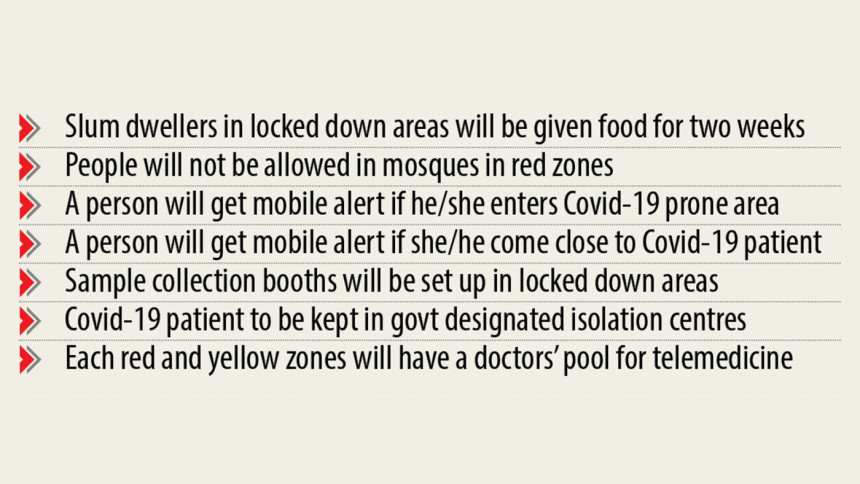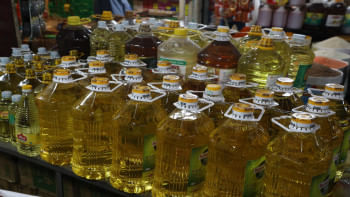Covid-19 Red Zones: Strict rules for stay at home

Facing setbacks in its plan to enforce containment zones in four districts from yesterday, the government is now working to impose a total lockdown in areas that will be marked red and partially in the ones marked yellow in a day or two.
There will be strict stay-at-home orders for 15 days while groceries, drugs and other essentials will be delivered to people's homes in the areas marked red.
And no educational institution will reopen anywhere in the country until further orders.
The steps come amid continued spike in coronavirus cases.
Slum dwellers in the red zones or someone who suddenly lost their job will be provided with food for two weeks. Only the goods laden vehicles will be allowed to travel through the areas at night.
All offices and factories will remain closed and there will be restrictions on going to mosques too.
These and many other restrictions have been mentioned in the draft standard operating procedure (SOP) the government has prepared to curb the spread of Covid-19 in the cities.
In the yellow zones, grocery stores, pharmacies, and restaurants will remain open, but offices and factories may operate with 50 percent of their employees by informing the administration in advance. Public transport will operate with half the seats empty while rickshaws and three-wheelers will carry just one person.
The draft SOP was submitted before Prime Minister Sheikh Hasina on Saturday night and the cabinet division might issue a circular endorsing it in a day or two with edits suggested by the PM, officials familiar with the development said.
The Daily Star has obtained a copy of the draft SOP.
Meanwhile, local administration declared three areas in Narayanganj as red zones, and imposed lockdown for the next 15 days starting yesterday, to contain the growing number of coronavirus cases in those areas.
LACK OF PREPARATION HALTS INITIATIVE
The government originally planned to make what officials called containment zones in some areas of Dhaka, Narayanganj, Gazipur and Narsingdi from yesterday.
But that did not happen because the preliminary work had not been done, officials said.
There were areas under the capital's Wari and Sher-E-Bangla Nagar police stations that were to be containment zones.
Contacted yesterday, officers-in-charge of both the police stations said they had not received any directive from their high-ups regarding this.
Health ministry's medical cell chief Habibur Rahman Khan said, "There was an attempt at starting a zoning system from today. But…the background work was not complete.
"People directly involved in the process can tell you when the process will start."
Habibur, also an additional secretary of the ministry, said classifying areas as red, yellow and green zones was a time-consuming process.
Officials are also working to figure out how the restrictions will be enforced, he said.
Dhaka North City Corporation Mayor Atiqul Islam, who played a key role in preparing the draft SOP, told The Daily Star last night: "We hope to start [the zoning system] within a day or two… upon getting approval from the prime minister."
The mayor said he intended to start a lockdown as soon as possible.
The issue was discussed at a meeting on June 1 chaired by Health Minister Zahid Maleque and attended by mayors from three cities.
The suggestion of classifying different areas was made by health experts after the government on May 31 relaxed the nationwide shutdown enforced on March 26.
The suggestion was then discussed at another high-level meeting this week attended by the health, home, local government and rural development ministers, and the two mayors of Dhaka.
As per the decisions, city areas will be marked as green, yellow and red zones based on the number of cases detected in a ward, its population density and people's living standard.
The eight-member government expert panel formed to supervise, monitor and support the coronavirus response prepared a draft of recommendations on the zoning system.
Areas with no recorded Covid-19 case will be marked green while those with less than 40 detected cases will be yellow. If the area is densely populated and the living standard is low, the number should be less than 30.
A ward will be put in the "red zone" if it has more than 40 cases. If population density is high, the number considered should be 30, according to the draft recommendation.
THE DRAFT SOP
According to the draft, there will be two committees implementing the zoning system.
A 10-member committee led by the mayor of the city will choose the zones where interventions should be urgent. The zones were identified by the Directorate General of Health Services (DGHS).
Other members of the committee will be representatives from the DGHS, police, administration, A2I, NGOs and ward councilors while local lawmakers will work as advisers.
The other committee will be for management of a zone. It will be led by councilors. Other members will include local political leaders selected by the lawmaker, representatives from NOGs, DGHS and e-commerce association, officer-in-charge of police station, and imam of a local mosque.
Following directives from the other committee, they will enforce a total lockdown by mobilising people to follow the rules and ensuring people's civic amenities.
A person will get a mobile alert if they enter a risky area and come close to a coronavirus-infected person.
People will get alerts about the status of an area on their phones. The information will also be available in social and electronic media.
Sample collection booths will be installed in red zones to ensure testing and law enforcers will be strict in ensuring that those infected are quarantined in red and yellow zones.
Vigilance by armed forces will continue and mobile courts will punish violators.
There will be a pool of physicians, including psychiatrists and psychologists, in red and yellow zones.
If anyone dies in an area under lockdown, the burial will be done by any non-government organisations like Anjuman Mofidul Islam.
Police permission will be needed for a resident of such an area to go outside for better treatment. But they must manage their own ambulance.
There will be fences at the entrance of the red and yellow zones.



 For all latest news, follow The Daily Star's Google News channel.
For all latest news, follow The Daily Star's Google News channel. 



Comments